Abstract
The humoral immune response of inbred mice to immunization with the glucuronoxylomannan (GXM) of Cryptococcus neoformans was investigated both serologically and in plaque-forming cells (PFCs). The T-helper-cell-independent quality of the GXM was demonstrated by using BALB/c nu/nu mice. Primary and secondary dose responses to three antigenic forms of GXM, (i) the native antigen, (ii) a GXM-bovine serum albumin protein conjugate, and (iii) a cryptococcal whole-cell vaccine, revealed a lack of isotype class switching and anamnestic responses. Both the levels of complement-fixing anti-GXM antibody in serum and the PFC responses in the athymic mice showed no significant differences from those in the wild-type controls. However, T cells are involved in the suppression of the primary response to GXM. When BALB/cBy mice were given rabbit anti-mouse thymocyte serum along with 0.5 microgram of GXM, both antibody levels in serum and PFC responses were significantly increased over those of control mice that received GXM and normal rabbit serum. In addition, T cells were also shown to enhance the primary immune response to GXM. BALB/cBy mice were given GXM and anti-mouse thymocyte serum on day 1. On day 2, the experimental group was given anti-mouse thymocyte serum and the control group was given saline. On day 5, comparison of the PFC responses and anti-GXM antibody titers of the two groups revealed a significant increase in the immune response of the control over the experimental group. The type 2 T-cell-independent quality of GXM was also demonstrated in CBA/cHN xid mice. These mice lack the Lyb+ subset of B cells and are unable to respond to type 2 T-independent antigens but respond normally to type 1 T-independent antigens. Type III pneumococcal polysaccharide, a type 2 T-independent antigen, was used as a negative control, and trinitrophenyl-lipopolysaccharide, a type 1 T-independent antigen, was used as a positive control. The CBA/cHN xid mice failed to respond to either type III pneumococcal polysaccharide or GXM but did not respond to immunization with trinitrophenyl-lipopolysaccharide. BALB/cBy mice responded normally to all three antigens.
Full text
PDF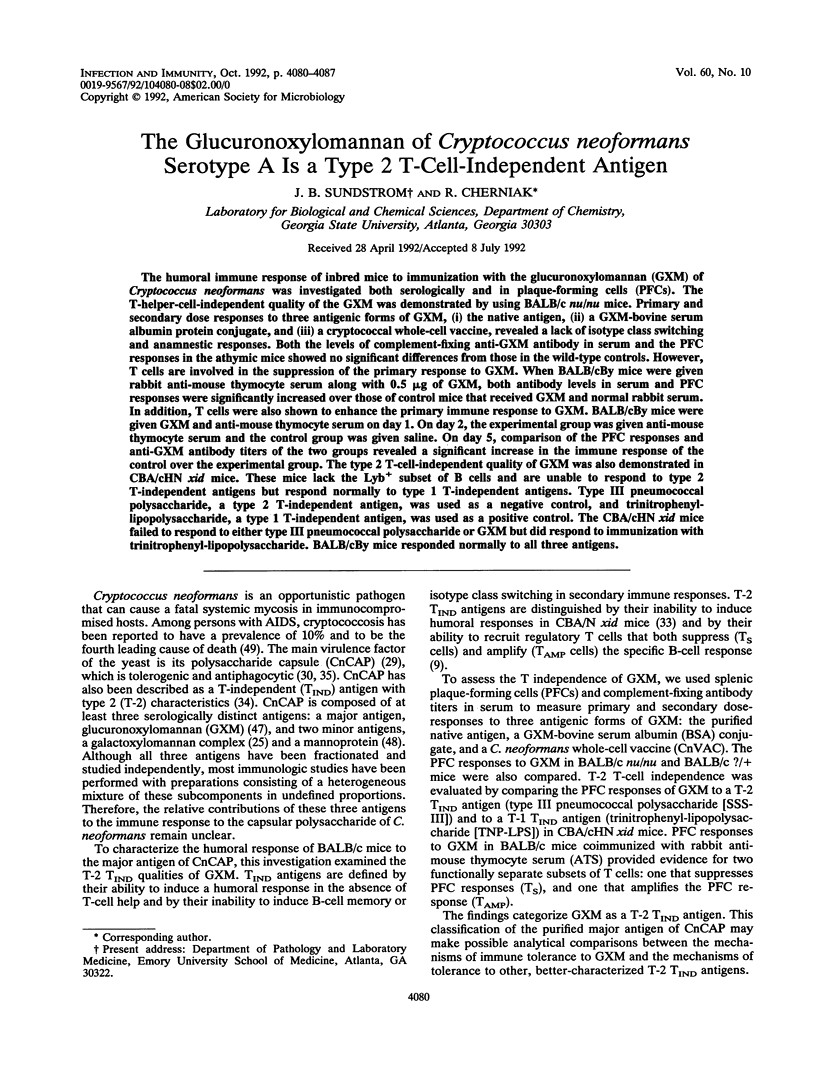
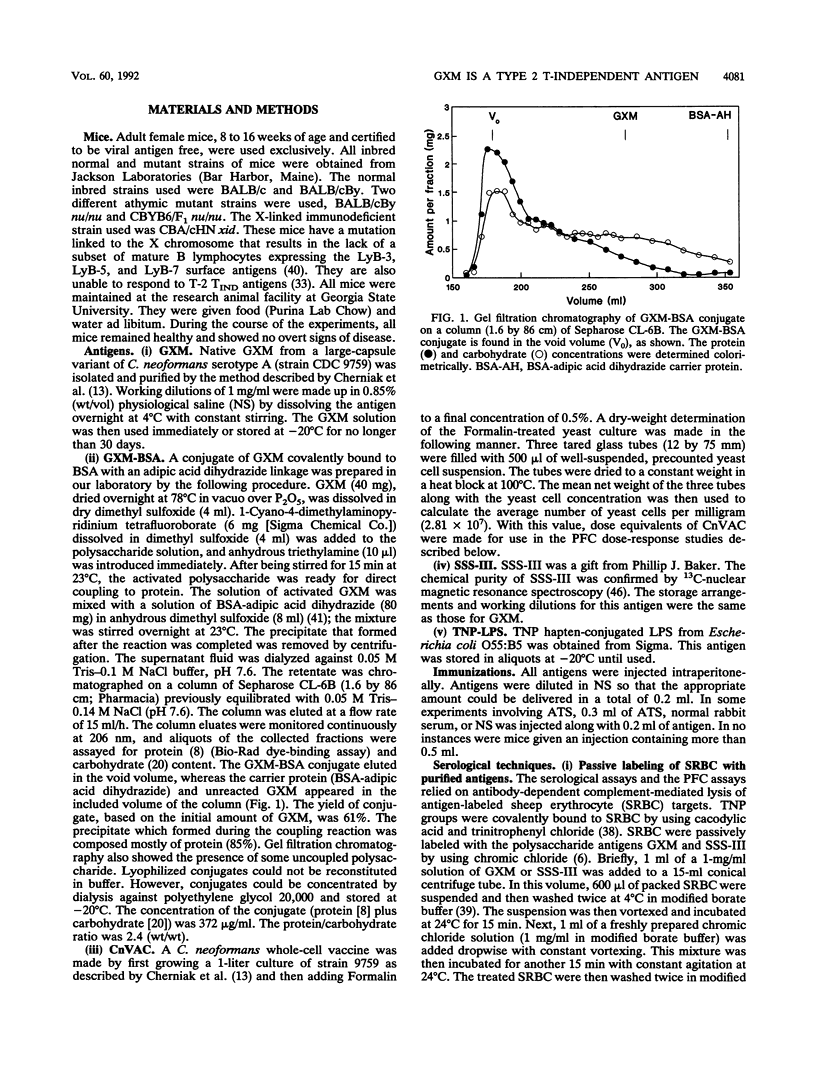

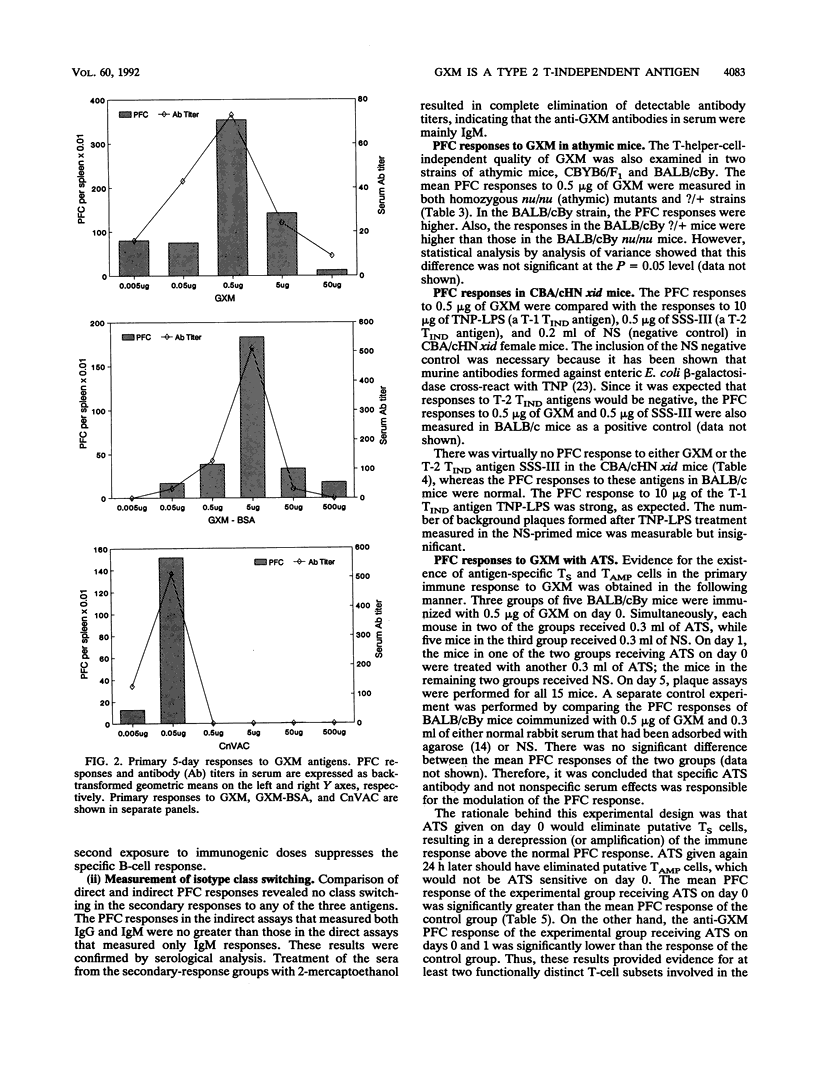
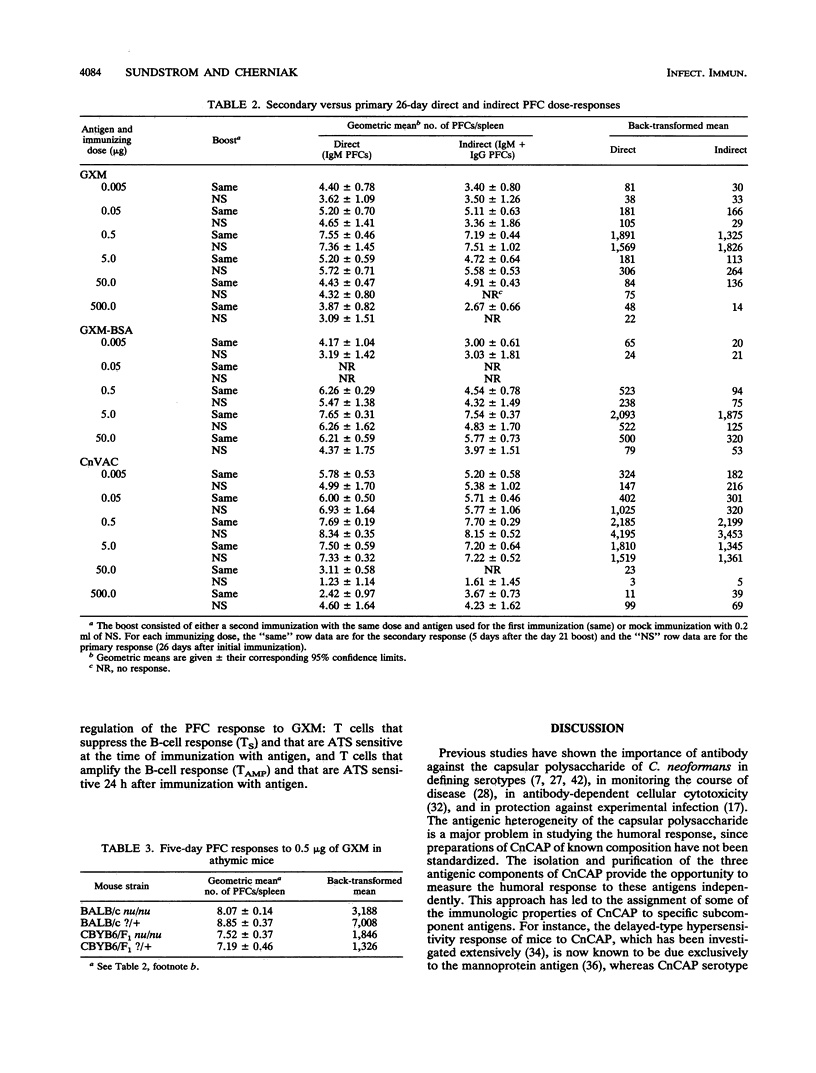
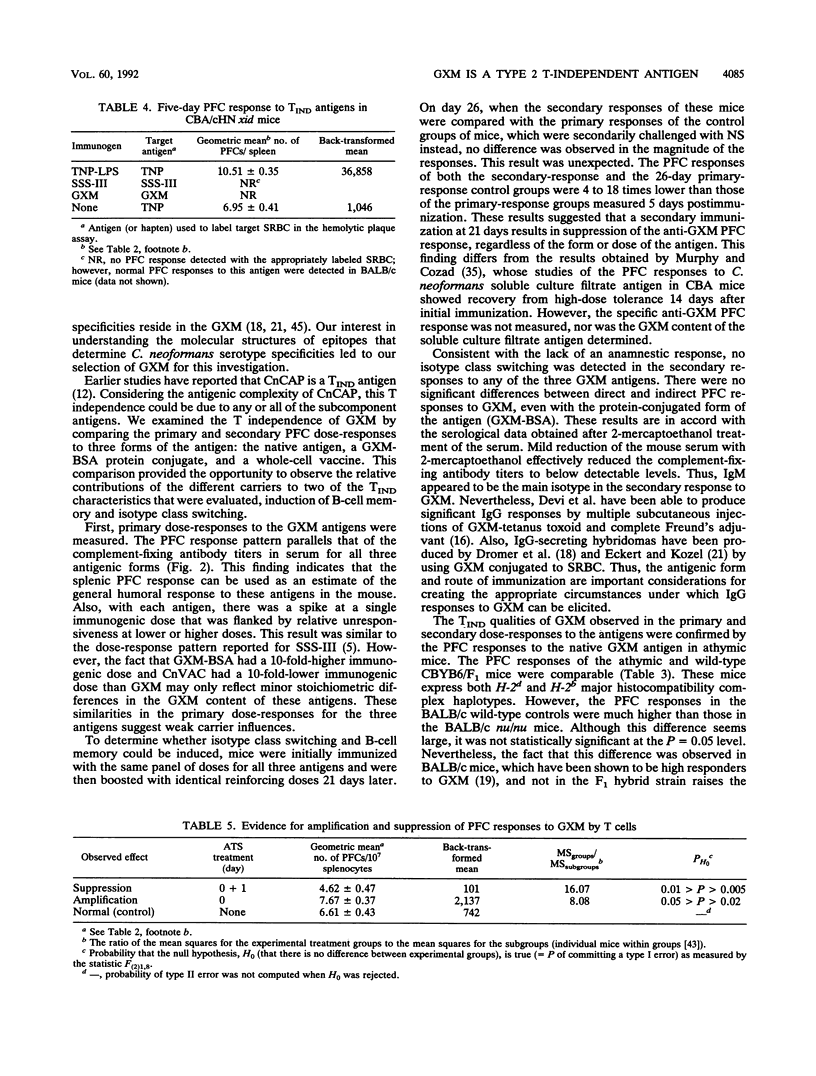
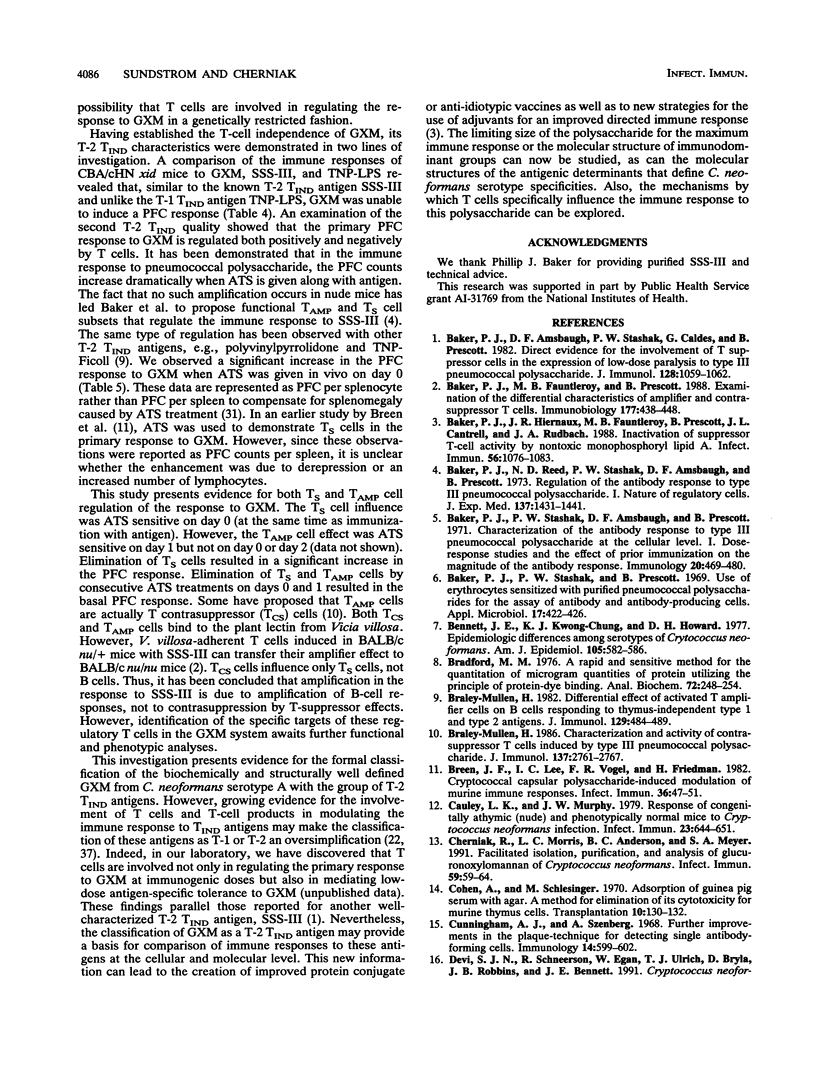
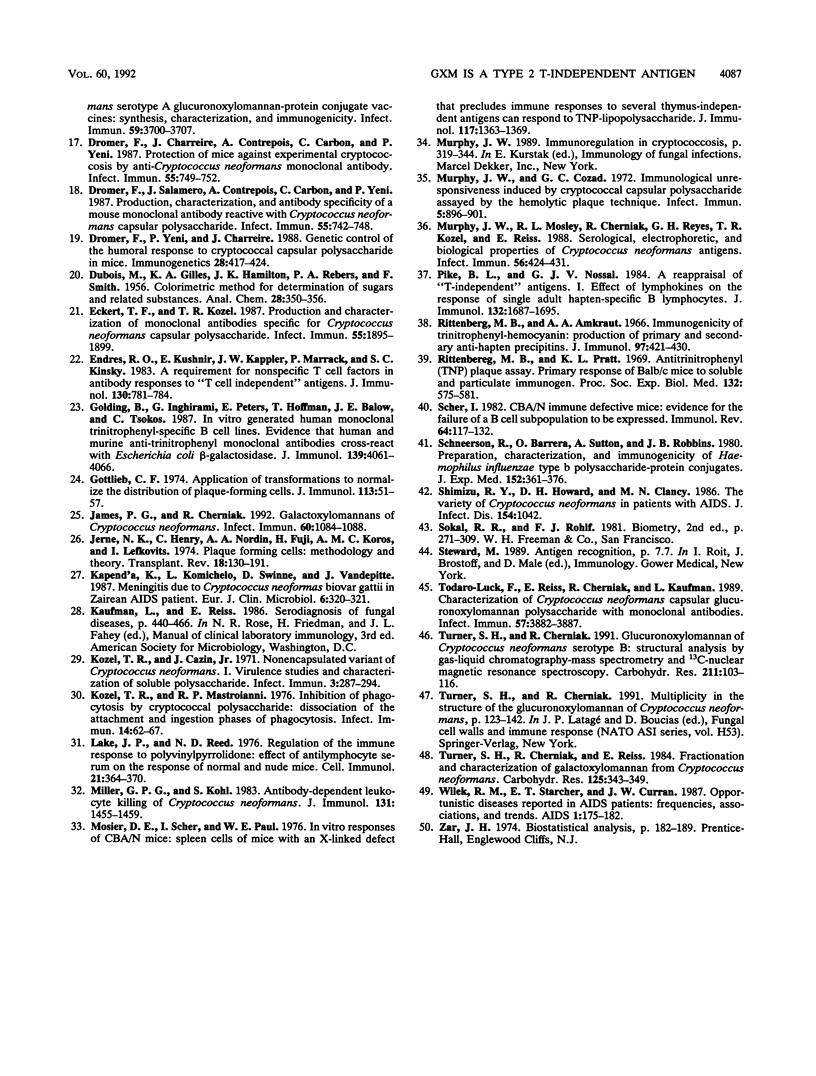
Selected References
These references are in PubMed. This may not be the complete list of references from this article.
- Baker P. J., Amsbaugh D. F., Stashak P. W., Caldes G., Prescott B. Direct evidence for the involvement of T suppressor cells in the expression of low-dose paralysis to type III pneumococcal polysaccharide. J Immunol. 1982 Mar;128(3):1059–1062. [PubMed] [Google Scholar]
- Baker P. J., Fauntleroy M. B., Prescott B. Examination of the differential characteristics of amplifier and contrasuppressor T cells. Immunobiology. 1988 Sep;177(4-5):438–448. doi: 10.1016/S0171-2985(88)80010-X. [DOI] [PubMed] [Google Scholar]
- Baker P. J., Hiernaux J. R., Fauntleroy M. B., Prescott B., Cantrell J. L., Rudbach J. A. Inactivation of suppressor T-cell activity by nontoxic monophosphoryl lipid A. Infect Immun. 1988 May;56(5):1076–1083. doi: 10.1128/iai.56.5.1076-1083.1988. [DOI] [PMC free article] [PubMed] [Google Scholar]
- Baker P. J., Reed N. D., Stashak P. W., Amsbaugh D. F., Prescott B. Regulation of the antibody response to type 3 pneumococcal polysaccharide. I. Nature of regulatory cells. J Exp Med. 1973 Jun 1;137(6):1431–1441. doi: 10.1084/jem.137.6.1431. [DOI] [PMC free article] [PubMed] [Google Scholar]
- Baker P. J., Stashak P. W., Amsbaugh D. F., Prescott B. Characterization of the antibody response to type 3 pneumococcal polysaccharide at the cellular level. I. Dose-response studies and the effect of prior immunization on the magnitude of the antibody response. Immunology. 1971 Apr;20(4):469–480. [PMC free article] [PubMed] [Google Scholar]
- Baker P. J., Stashak P. W., Prescott B. Use of erythrocytes sensitized with purified pneumococcal polysaccharides for the assay of antibody and antibody-producing cells. Appl Microbiol. 1969 Mar;17(3):422–426. doi: 10.1128/am.17.3.422-426.1969. [DOI] [PMC free article] [PubMed] [Google Scholar]
- Bennett J. E., Kwon-Chung K. J., Howard D. H. Epidemiologic differences among serotypes of Cryptococcus neoformans. Am J Epidemiol. 1977 Jun;105(6):582–586. doi: 10.1093/oxfordjournals.aje.a112423. [DOI] [PubMed] [Google Scholar]
- Bradford M. M. A rapid and sensitive method for the quantitation of microgram quantities of protein utilizing the principle of protein-dye binding. Anal Biochem. 1976 May 7;72:248–254. doi: 10.1016/0003-2697(76)90527-3. [DOI] [PubMed] [Google Scholar]
- Braley-Mullen H. Characterization and activity of contrasuppressor T cells induced by type III pneumococcal polysaccharide. J Immunol. 1986 Nov 1;137(9):2761–2767. [PubMed] [Google Scholar]
- Braley-Mullen H. Differential effect of activated T amplifier cells on B cells responding to thymus-independent type 1 and type 2 antigens. J Immunol. 1982 Aug;129(2):484–489. [PubMed] [Google Scholar]
- Breen J. F., Lee I. C., Vogel F. R., Friedman H. Cryptococcal capsular polysaccharide-induced modulation of murine immune responses. Infect Immun. 1982 Apr;36(1):47–51. doi: 10.1128/iai.36.1.47-51.1982. [DOI] [PMC free article] [PubMed] [Google Scholar]
- Cauley L. K., Murphy J. W. Response of congenitally athymic (nude) and phenotypically normal mice to Cryptococcus neoformans infection. Infect Immun. 1979 Mar;23(3):644–651. doi: 10.1128/iai.23.3.644-651.1979. [DOI] [PMC free article] [PubMed] [Google Scholar]
- Cherniak R., Morris L. C., Anderson B. C., Meyer S. A. Facilitated isolation, purification, and analysis of glucuronoxylomannan of Cryptococcus neoformans. Infect Immun. 1991 Jan;59(1):59–64. doi: 10.1128/iai.59.1.59-64.1991. [DOI] [PMC free article] [PubMed] [Google Scholar]
- Cohen A., Schlesinger M. Absorption of guinea pig serum with agar. A method for elimination of itscytotoxicity for murine thymus cells. Transplantation. 1970 Jul;10(1):130–132. doi: 10.1097/00007890-197007000-00027. [DOI] [PubMed] [Google Scholar]
- Cunningham A. J., Szenberg A. Further improvements in the plaque technique for detecting single antibody-forming cells. Immunology. 1968 Apr;14(4):599–600. [PMC free article] [PubMed] [Google Scholar]
- Devi S. J., Schneerson R., Egan W., Ulrich T. J., Bryla D., Robbins J. B., Bennett J. E. Cryptococcus neoformans serotype A glucuronoxylomannan-protein conjugate vaccines: synthesis, characterization, and immunogenicity. Infect Immun. 1991 Oct;59(10):3700–3707. doi: 10.1128/iai.59.10.3700-3707.1991. [DOI] [PMC free article] [PubMed] [Google Scholar]
- Dromer F., Charreire J., Contrepois A., Carbon C., Yeni P. Protection of mice against experimental cryptococcosis by anti-Cryptococcus neoformans monoclonal antibody. Infect Immun. 1987 Mar;55(3):749–752. doi: 10.1128/iai.55.3.749-752.1987. [DOI] [PMC free article] [PubMed] [Google Scholar]
- Dromer F., Salamero J., Contrepois A., Carbon C., Yeni P. Production, characterization, and antibody specificity of a mouse monoclonal antibody reactive with Cryptococcus neoformans capsular polysaccharide. Infect Immun. 1987 Mar;55(3):742–748. doi: 10.1128/iai.55.3.742-748.1987. [DOI] [PMC free article] [PubMed] [Google Scholar]
- Dromer F., Yeni P., Charreire J. Genetic control of the humoral response to cryptococcal capsular polysaccharide in mice. Immunogenetics. 1988;28(6):417–424. doi: 10.1007/BF00355373. [DOI] [PubMed] [Google Scholar]
- Eckert T. F., Kozel T. R. Production and characterization of monoclonal antibodies specific for Cryptococcus neoformans capsular polysaccharide. Infect Immun. 1987 Aug;55(8):1895–1899. doi: 10.1128/iai.55.8.1895-1899.1987. [DOI] [PMC free article] [PubMed] [Google Scholar]
- Endres R. O., Kushnir E., Kappler J. W., Marrack P., Kinsky S. C. A requirement for nonspecific T cell factors in antibody responses to "T cell independent" antigens. J Immunol. 1983 Feb;130(2):781–784. [PubMed] [Google Scholar]
- Golding B., Inghirami G., Peters E., Hoffman T., Balow J. E., Tsokos G. C. In vitro generated human monoclonal trinitrophenyl-specific B cell lines. Evidence that human and murine anti-trinitrophenyl monoclonal antibodies cross-react with Escherichia coli beta-galactosidase. J Immunol. 1987 Dec 15;139(12):4061–4066. [PubMed] [Google Scholar]
- Gottlieb C. F. Application of transformations to normalize the distribution of plaque-forming cells. J Immunol. 1974 Jul;113(1):51–57. [PubMed] [Google Scholar]
- James P. G., Cherniak R. Galactoxylomannans of Cryptococcus neoformans. Infect Immun. 1992 Mar;60(3):1084–1088. doi: 10.1128/iai.60.3.1084-1088.1992. [DOI] [PMC free article] [PubMed] [Google Scholar]
- Jerne N. K., Henry C., Nordin A. A., Fuji H., Koros A. M., Lefkovits I. Plaque forming cells: methodology and theory. Transplant Rev. 1974;18:130–191. doi: 10.1111/j.1600-065x.1974.tb01588.x. [DOI] [PubMed] [Google Scholar]
- Kapend'a K., Komichelo K., Swinne D., Vandepitte J. Meningitis due to Cryptococcus neoformans biovar gattii in a Zairean AIDS patient. Eur J Clin Microbiol. 1987 Jun;6(3):320–321. doi: 10.1007/BF02017627. [DOI] [PubMed] [Google Scholar]
- Kozel T. R., Cazin J. Nonencapsulated Variant of Cryptococcus neoformans I. Virulence Studies and Characterization of Soluble Polysaccharide. Infect Immun. 1971 Feb;3(2):287–294. doi: 10.1128/iai.3.2.287-294.1971. [DOI] [PMC free article] [PubMed] [Google Scholar]
- Kozel T. R., Mastroianni R. P. Inhibition of phagocytosis by cryptococcal polysaccharide: dissociation of the attachment and ingestion phases of phagocytosis. Infect Immun. 1976 Jul;14(1):62–67. doi: 10.1128/iai.14.1.62-67.1976. [DOI] [PMC free article] [PubMed] [Google Scholar]
- Lake J. P., Reed N. D. Regulation of the immune response to polyvinylpyrrolidone:effect of antilymphocyte serum on the response of normal and nude mice. Cell Immunol. 1976 Feb;21(2):364–370. doi: 10.1016/0008-8749(76)90065-4. [DOI] [PubMed] [Google Scholar]
- Miller G. P., Kohl S. Antibody-dependent leukocyte killing of Cryptococcus neoformans. J Immunol. 1983 Sep;131(3):1455–1459. [PubMed] [Google Scholar]
- Mosier D. E., Scher I., Paul W. E. In vitro responses of CBA/N mice: spleen cells of mice with an X-linked defect that precludes immune responses to several thymus-independent antigens can respond to TNP-lipopolysaccharide. J Immunol. 1976 Oct;117(4):1363–1369. [PubMed] [Google Scholar]
- Murphy J. W., Cozad G. C. Immunological unresponsiveness induced by cryptococcal capsular polysaccharide assayed by the hemolytic plaque technique. Infect Immun. 1972 Jun;5(6):896–901. doi: 10.1128/iai.5.6.896-901.1972. [DOI] [PMC free article] [PubMed] [Google Scholar]
- Murphy J. W., Mosley R. L., Cherniak R., Reyes G. H., Kozel T. R., Reiss E. Serological, electrophoretic, and biological properties of Cryptococcus neoformans antigens. Infect Immun. 1988 Feb;56(2):424–431. doi: 10.1128/iai.56.2.424-431.1988. [DOI] [PMC free article] [PubMed] [Google Scholar]
- Pike B. L., Nossal G. J. A reappraisal of "T-independent" antigens. I. Effect of lymphokines on the response of single adult hapten-specific B lymphocytes. J Immunol. 1984 Apr;132(4):1687–1695. [PubMed] [Google Scholar]
- Rittenberg M. B., Amkraut A. A. Immunogenicity of trinitrophenyl-hemocyanin: production of primary and secondary anti-hapten precipitins. J Immunol. 1966 Sep;97(3):421–430. [PubMed] [Google Scholar]
- Rittenberg M. B., Pratt K. L. Antitrinitrophenyl (TNP) plaque assay. Primary response of Balb/c mice to soluble and particulate immunogen. Proc Soc Exp Biol Med. 1969 Nov;132(2):575–581. doi: 10.3181/00379727-132-34264. [DOI] [PubMed] [Google Scholar]
- Scher I. CBA/N immune defective mice; evidence for the failure of a B cell subpopulation to be expressed. Immunol Rev. 1982;64:117–136. doi: 10.1111/j.1600-065x.1982.tb00421.x. [DOI] [PubMed] [Google Scholar]
- Schneerson R., Barrera O., Sutton A., Robbins J. B. Preparation, characterization, and immunogenicity of Haemophilus influenzae type b polysaccharide-protein conjugates. J Exp Med. 1980 Aug 1;152(2):361–376. doi: 10.1084/jem.152.2.361. [DOI] [PMC free article] [PubMed] [Google Scholar]
- Selik R. M., Starcher E. T., Curran J. W. Opportunistic diseases reported in AIDS patients: frequencies, associations, and trends. AIDS. 1987 Sep;1(3):175–182. [PubMed] [Google Scholar]
- Shimizu R. Y., Howard D. H., Clancy M. N. The variety of Cryptococcus neoformans in patients with AIDS. J Infect Dis. 1986 Dec;154(6):1042–1042. doi: 10.1093/infdis/154.6.1042. [DOI] [PubMed] [Google Scholar]
- Todaro-Luck F., Reiss E., Cherniak R., Kaufman L. Characterization of Cryptococcus neoformans capsular glucuronoxylomannan polysaccharide with monoclonal antibodies. Infect Immun. 1989 Dec;57(12):3882–3887. doi: 10.1128/iai.57.12.3882-3887.1989. [DOI] [PMC free article] [PubMed] [Google Scholar]
- Turner S. H., Cherniak R. Glucuronoxylomannan of Cryptococcus neoformans serotype B: structural analysis by gas-liquid chromatography-mass spectrometry and 13C-nuclear magnetic resonance spectroscopy. Carbohydr Res. 1991 Apr 2;211(1):103–116. doi: 10.1016/0008-6215(91)84149-9. [DOI] [PubMed] [Google Scholar]
- Turner S. H., Cherniak R., Reiss E. Fractionation and characterization of galactoxylomannan from Cryptococcus neoformans. Carbohydr Res. 1984 Feb 15;125(2):343–349. doi: 10.1016/0008-6215(84)85172-1. [DOI] [PubMed] [Google Scholar]


